Marketing Principles and McDonald's Case Study Analysis
VerifiedAdded on 2020/06/04
|20
|5458
|101
Report
AI Summary
This report provides a comprehensive overview of marketing principles, using McDonald's as a case study to illustrate key concepts. It begins by outlining the elements of the marketing process, including situational analysis, marketing objectives, strategy, and the marketing mix. The report then assesses the advantages and costs of a marketing orientation, comparing different concepts like production, product, and marketing concepts. It delves into the micro and macro environmental factors influencing McDonald's marketing decisions, such as demographic, economic, technological, political, and cultural environments. Furthermore, the report proposes segmentation measures, highlighting behavioral and psychographic segmentation, and discusses targeting strategies, including differentiated, focused, and customized approaches. Finally, it signifies how customer buying behavior affects marketing activities across various buying conditions, such as complex, dissonance-reducing, habitual, and variety-seeking behaviors, and how McDonald's adapts its strategies accordingly. The report also covers distribution and promotional strategies, and other elements of the marketing mix.

MARKETING
PRINCIPLES
PRINCIPLES
Paraphrase This Document
Need a fresh take? Get an instant paraphrase of this document with our AI Paraphraser
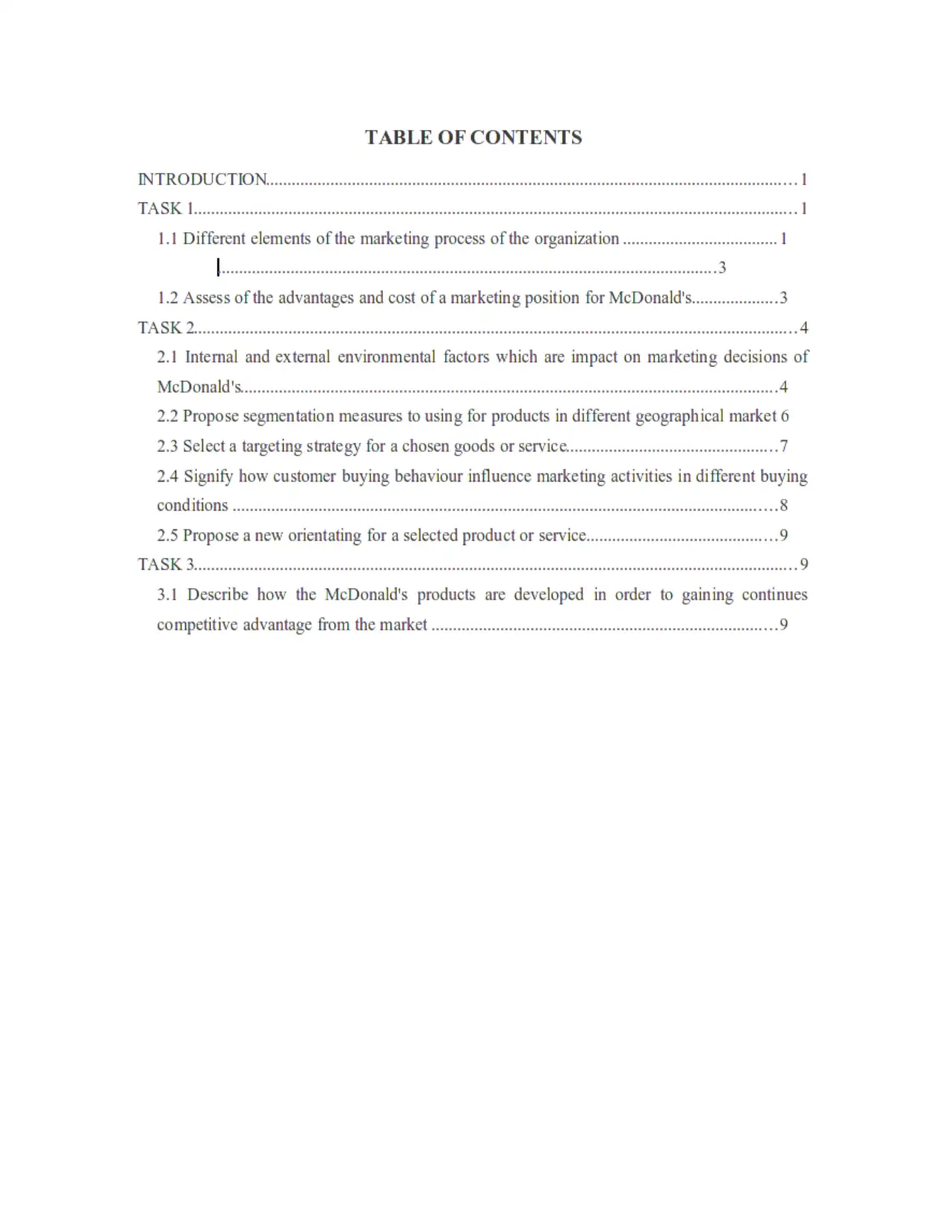

⊘ This is a preview!⊘
Do you want full access?
Subscribe today to unlock all pages.

Trusted by 1+ million students worldwide
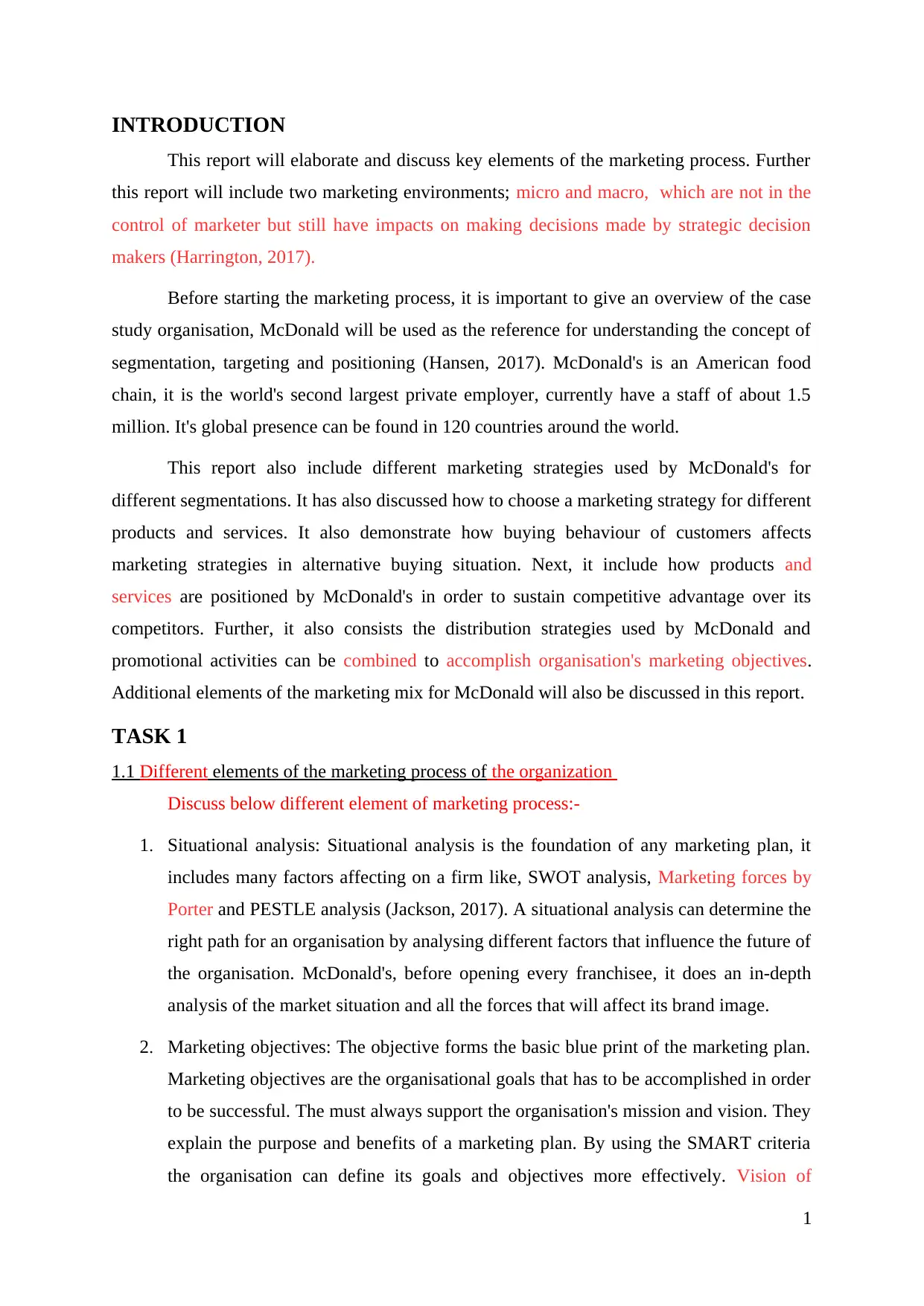
INTRODUCTION
This report will elaborate and discuss key elements of the marketing process. Further
this report will include two marketing environments; micro and macro, which are not in the
control of marketer but still have impacts on making decisions made by strategic decision
makers (Harrington, 2017).
Before starting the marketing process, it is important to give an overview of the case
study organisation, McDonald will be used as the reference for understanding the concept of
segmentation, targeting and positioning (Hansen, 2017). McDonald's is an American food
chain, it is the world's second largest private employer, currently have a staff of about 1.5
million. It's global presence can be found in 120 countries around the world.
This report also include different marketing strategies used by McDonald's for
different segmentations. It has also discussed how to choose a marketing strategy for different
products and services. It also demonstrate how buying behaviour of customers affects
marketing strategies in alternative buying situation. Next, it include how products and
services are positioned by McDonald's in order to sustain competitive advantage over its
competitors. Further, it also consists the distribution strategies used by McDonald and
promotional activities can be combined to accomplish organisation's marketing objectives.
Additional elements of the marketing mix for McDonald will also be discussed in this report.
TASK 1
1.1 Different elements of the marketing process of the organization
Discuss below different element of marketing process:-
1. Situational analysis: Situational analysis is the foundation of any marketing plan, it
includes many factors affecting on a firm like, SWOT analysis, Marketing forces by
Porter and PESTLE analysis (Jackson, 2017). A situational analysis can determine the
right path for an organisation by analysing different factors that influence the future of
the organisation. McDonald's, before opening every franchisee, it does an in-depth
analysis of the market situation and all the forces that will affect its brand image.
2. Marketing objectives: The objective forms the basic blue print of the marketing plan.
Marketing objectives are the organisational goals that has to be accomplished in order
to be successful. The must always support the organisation's mission and vision. They
explain the purpose and benefits of a marketing plan. By using the SMART criteria
the organisation can define its goals and objectives more effectively. Vision of
1
This report will elaborate and discuss key elements of the marketing process. Further
this report will include two marketing environments; micro and macro, which are not in the
control of marketer but still have impacts on making decisions made by strategic decision
makers (Harrington, 2017).
Before starting the marketing process, it is important to give an overview of the case
study organisation, McDonald will be used as the reference for understanding the concept of
segmentation, targeting and positioning (Hansen, 2017). McDonald's is an American food
chain, it is the world's second largest private employer, currently have a staff of about 1.5
million. It's global presence can be found in 120 countries around the world.
This report also include different marketing strategies used by McDonald's for
different segmentations. It has also discussed how to choose a marketing strategy for different
products and services. It also demonstrate how buying behaviour of customers affects
marketing strategies in alternative buying situation. Next, it include how products and
services are positioned by McDonald's in order to sustain competitive advantage over its
competitors. Further, it also consists the distribution strategies used by McDonald and
promotional activities can be combined to accomplish organisation's marketing objectives.
Additional elements of the marketing mix for McDonald will also be discussed in this report.
TASK 1
1.1 Different elements of the marketing process of the organization
Discuss below different element of marketing process:-
1. Situational analysis: Situational analysis is the foundation of any marketing plan, it
includes many factors affecting on a firm like, SWOT analysis, Marketing forces by
Porter and PESTLE analysis (Jackson, 2017). A situational analysis can determine the
right path for an organisation by analysing different factors that influence the future of
the organisation. McDonald's, before opening every franchisee, it does an in-depth
analysis of the market situation and all the forces that will affect its brand image.
2. Marketing objectives: The objective forms the basic blue print of the marketing plan.
Marketing objectives are the organisational goals that has to be accomplished in order
to be successful. The must always support the organisation's mission and vision. They
explain the purpose and benefits of a marketing plan. By using the SMART criteria
the organisation can define its goals and objectives more effectively. Vision of
1
Paraphrase This Document
Need a fresh take? Get an instant paraphrase of this document with our AI Paraphraser
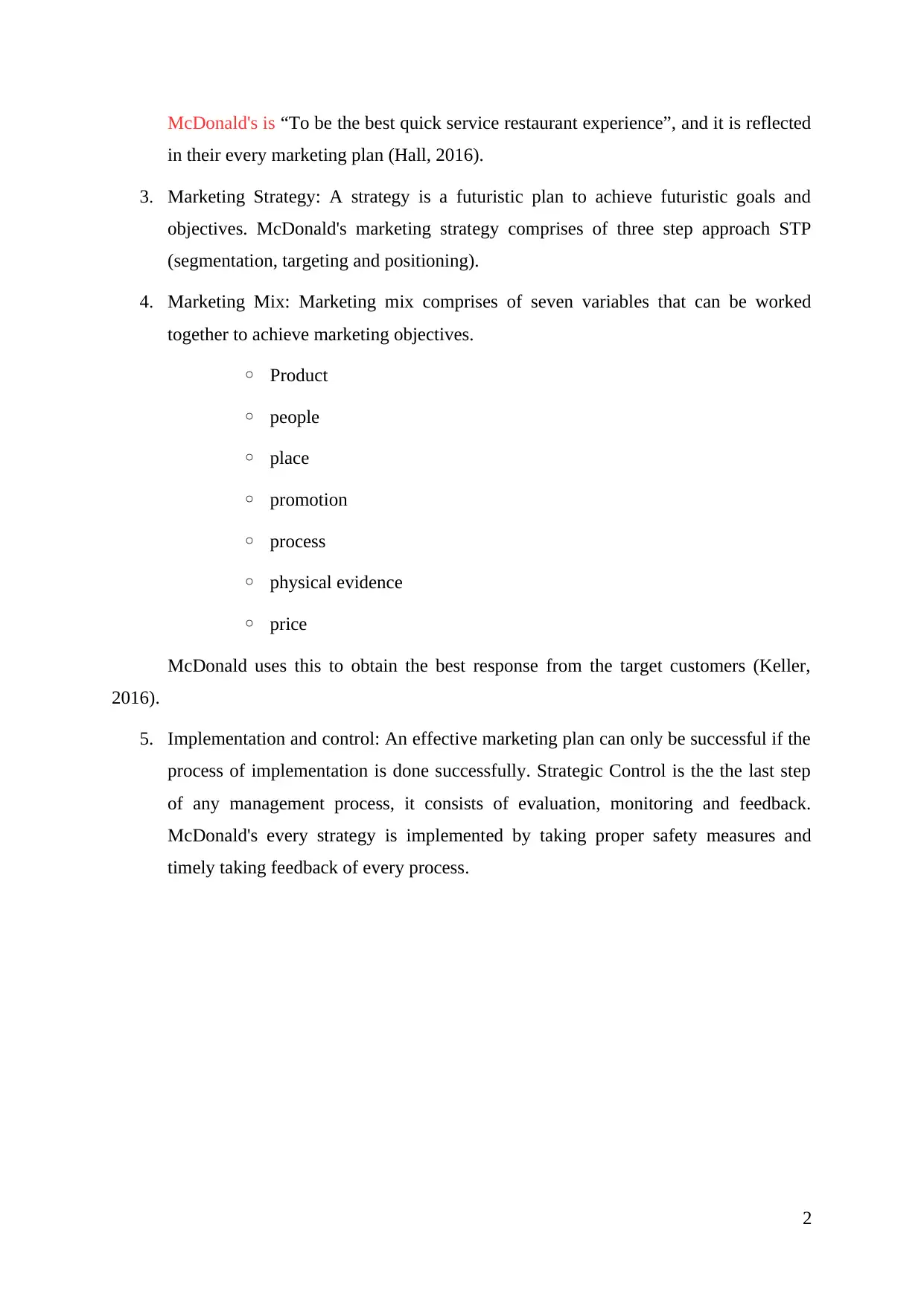
McDonald's is “To be the best quick service restaurant experience”, and it is reflected
in their every marketing plan (Hall, 2016).
3. Marketing Strategy: A strategy is a futuristic plan to achieve futuristic goals and
objectives. McDonald's marketing strategy comprises of three step approach STP
(segmentation, targeting and positioning).
4. Marketing Mix: Marketing mix comprises of seven variables that can be worked
together to achieve marketing objectives.
◦ Product
◦ people
◦ place
◦ promotion
◦ process
◦ physical evidence
◦ price
McDonald uses this to obtain the best response from the target customers (Keller,
2016).
5. Implementation and control: An effective marketing plan can only be successful if the
process of implementation is done successfully. Strategic Control is the the last step
of any management process, it consists of evaluation, monitoring and feedback.
McDonald's every strategy is implemented by taking proper safety measures and
timely taking feedback of every process.
2
in their every marketing plan (Hall, 2016).
3. Marketing Strategy: A strategy is a futuristic plan to achieve futuristic goals and
objectives. McDonald's marketing strategy comprises of three step approach STP
(segmentation, targeting and positioning).
4. Marketing Mix: Marketing mix comprises of seven variables that can be worked
together to achieve marketing objectives.
◦ Product
◦ people
◦ place
◦ promotion
◦ process
◦ physical evidence
◦ price
McDonald uses this to obtain the best response from the target customers (Keller,
2016).
5. Implementation and control: An effective marketing plan can only be successful if the
process of implementation is done successfully. Strategic Control is the the last step
of any management process, it consists of evaluation, monitoring and feedback.
McDonald's every strategy is implemented by taking proper safety measures and
timely taking feedback of every process.
2
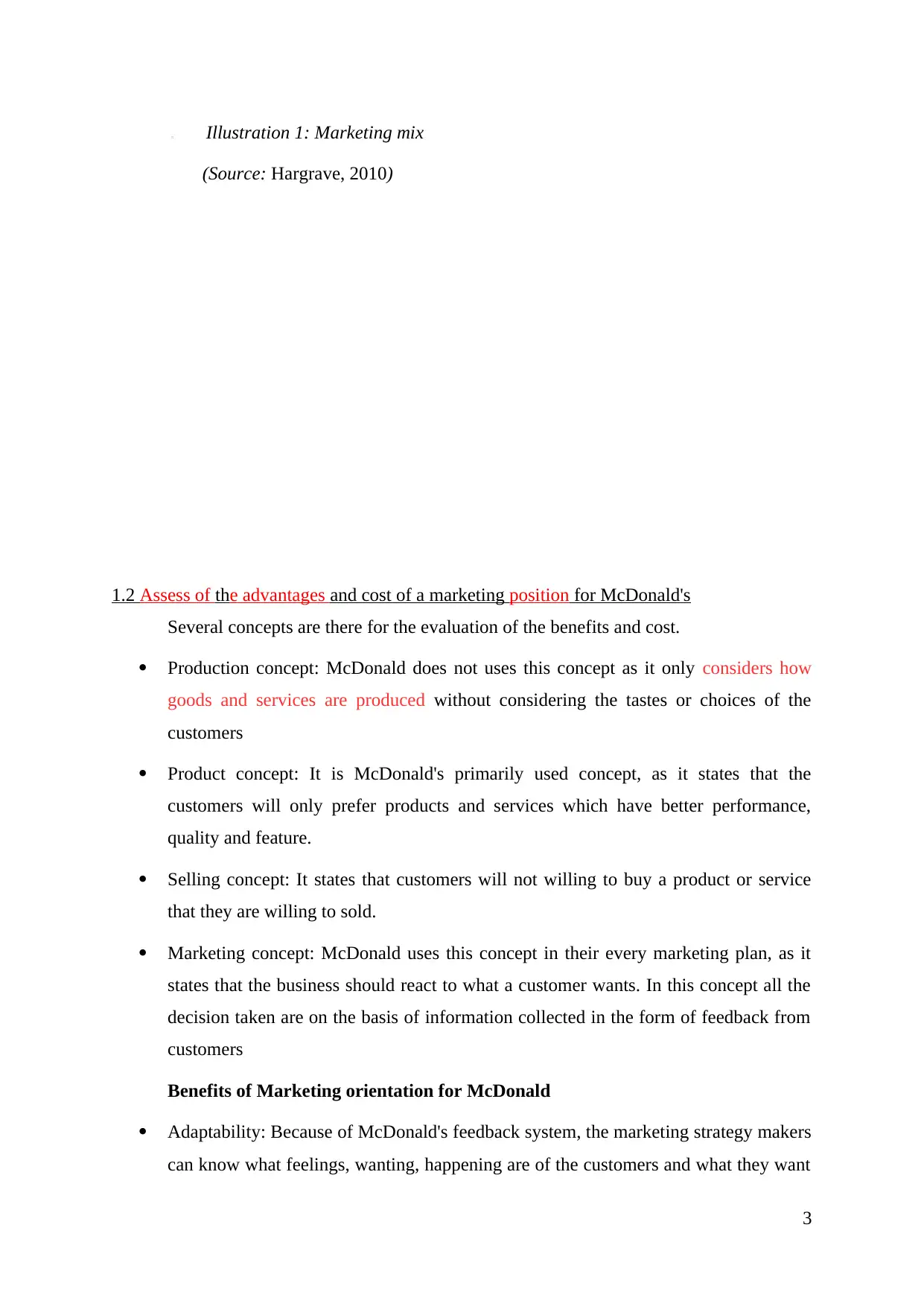
Illustration 1: Marketing mix
(Source: Hargrave, 2010)
1.2 Assess of the advantages and cost of a marketing position for McDonald's
Several concepts are there for the evaluation of the benefits and cost.
Production concept: McDonald does not uses this concept as it only considers how
goods and services are produced without considering the tastes or choices of the
customers
Product concept: It is McDonald's primarily used concept, as it states that the
customers will only prefer products and services which have better performance,
quality and feature.
Selling concept: It states that customers will not willing to buy a product or service
that they are willing to sold.
Marketing concept: McDonald uses this concept in their every marketing plan, as it
states that the business should react to what a customer wants. In this concept all the
decision taken are on the basis of information collected in the form of feedback from
customers
Benefits of Marketing orientation for McDonald
Adaptability: Because of McDonald's feedback system, the marketing strategy makers
can know what feelings, wanting, happening are of the customers and what they want
3
(Source: Hargrave, 2010)
1.2 Assess of the advantages and cost of a marketing position for McDonald's
Several concepts are there for the evaluation of the benefits and cost.
Production concept: McDonald does not uses this concept as it only considers how
goods and services are produced without considering the tastes or choices of the
customers
Product concept: It is McDonald's primarily used concept, as it states that the
customers will only prefer products and services which have better performance,
quality and feature.
Selling concept: It states that customers will not willing to buy a product or service
that they are willing to sold.
Marketing concept: McDonald uses this concept in their every marketing plan, as it
states that the business should react to what a customer wants. In this concept all the
decision taken are on the basis of information collected in the form of feedback from
customers
Benefits of Marketing orientation for McDonald
Adaptability: Because of McDonald's feedback system, the marketing strategy makers
can know what feelings, wanting, happening are of the customers and what they want
3
⊘ This is a preview!⊘
Do you want full access?
Subscribe today to unlock all pages.

Trusted by 1+ million students worldwide
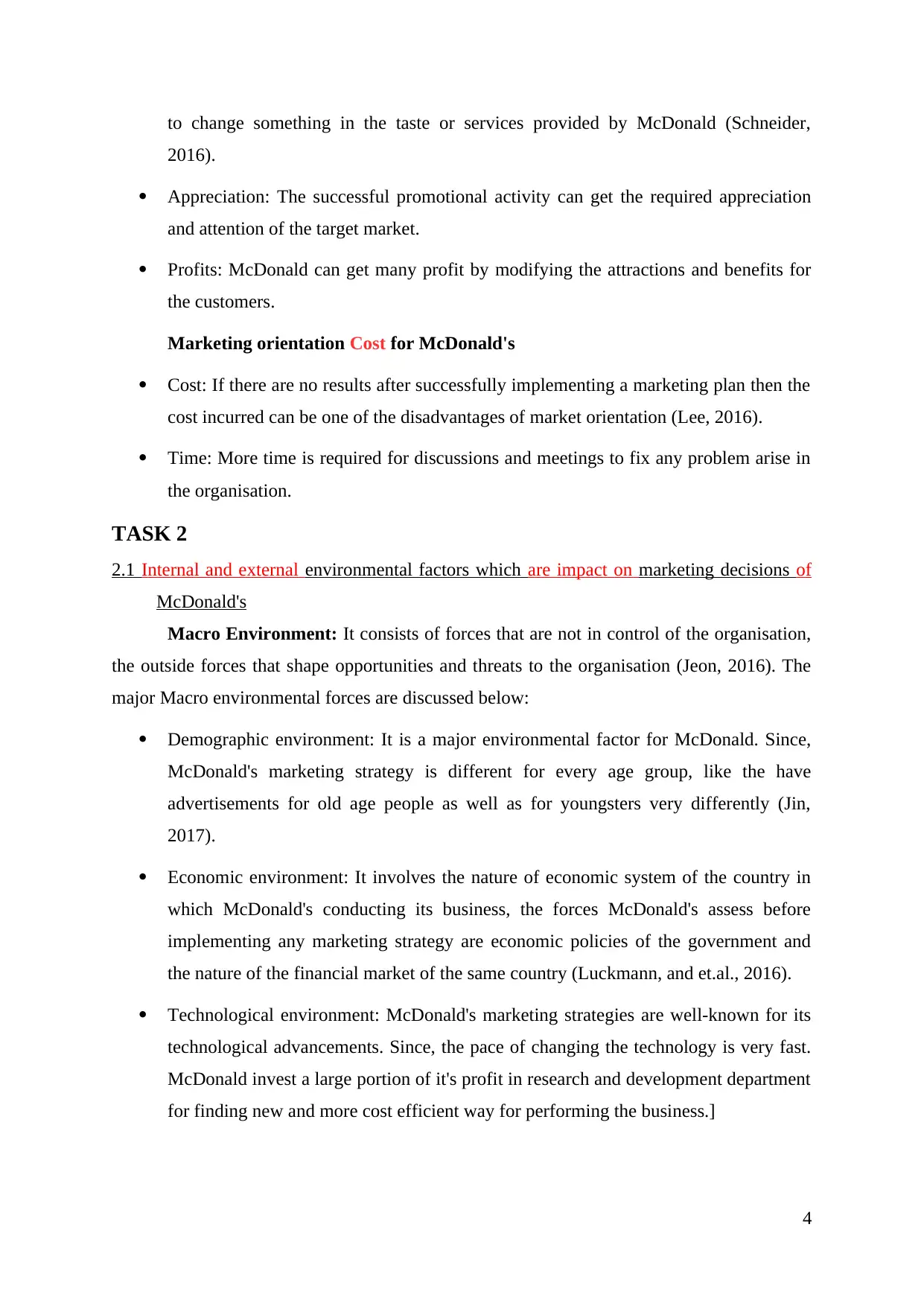
to change something in the taste or services provided by McDonald (Schneider,
2016).
Appreciation: The successful promotional activity can get the required appreciation
and attention of the target market.
Profits: McDonald can get many profit by modifying the attractions and benefits for
the customers.
Marketing orientation Cost for McDonald's
Cost: If there are no results after successfully implementing a marketing plan then the
cost incurred can be one of the disadvantages of market orientation (Lee, 2016).
Time: More time is required for discussions and meetings to fix any problem arise in
the organisation.
TASK 2
2.1 Internal and external environmental factors which are impact on marketing decisions of
McDonald's
Macro Environment: It consists of forces that are not in control of the organisation,
the outside forces that shape opportunities and threats to the organisation (Jeon, 2016). The
major Macro environmental forces are discussed below:
Demographic environment: It is a major environmental factor for McDonald. Since,
McDonald's marketing strategy is different for every age group, like the have
advertisements for old age people as well as for youngsters very differently (Jin,
2017).
Economic environment: It involves the nature of economic system of the country in
which McDonald's conducting its business, the forces McDonald's assess before
implementing any marketing strategy are economic policies of the government and
the nature of the financial market of the same country (Luckmann, and et.al., 2016).
Technological environment: McDonald's marketing strategies are well-known for its
technological advancements. Since, the pace of changing the technology is very fast.
McDonald invest a large portion of it's profit in research and development department
for finding new and more cost efficient way for performing the business.]
4
2016).
Appreciation: The successful promotional activity can get the required appreciation
and attention of the target market.
Profits: McDonald can get many profit by modifying the attractions and benefits for
the customers.
Marketing orientation Cost for McDonald's
Cost: If there are no results after successfully implementing a marketing plan then the
cost incurred can be one of the disadvantages of market orientation (Lee, 2016).
Time: More time is required for discussions and meetings to fix any problem arise in
the organisation.
TASK 2
2.1 Internal and external environmental factors which are impact on marketing decisions of
McDonald's
Macro Environment: It consists of forces that are not in control of the organisation,
the outside forces that shape opportunities and threats to the organisation (Jeon, 2016). The
major Macro environmental forces are discussed below:
Demographic environment: It is a major environmental factor for McDonald. Since,
McDonald's marketing strategy is different for every age group, like the have
advertisements for old age people as well as for youngsters very differently (Jin,
2017).
Economic environment: It involves the nature of economic system of the country in
which McDonald's conducting its business, the forces McDonald's assess before
implementing any marketing strategy are economic policies of the government and
the nature of the financial market of the same country (Luckmann, and et.al., 2016).
Technological environment: McDonald's marketing strategies are well-known for its
technological advancements. Since, the pace of changing the technology is very fast.
McDonald invest a large portion of it's profit in research and development department
for finding new and more cost efficient way for performing the business.]
4
Paraphrase This Document
Need a fresh take? Get an instant paraphrase of this document with our AI Paraphraser

Political environment: McDonald has to assess the political environment of the
country to have a legal framework within which the marketer has to operate its
functions (Rothaermel, 2016).
Cultural environment: It determines the value system of the society, through which
McDonald's marketing strategy is affected. Therefore, assessing the cultural
environment is very important, it consists of sociological factors like, culture heritage,
mobility of labour, customs, etcetera.
Micro environment: The environment which is in control of the organisation, that affect
positively or negatively and it create bond with customers. Some of the major Micro
environmental forces are discussed below:
Customers: It forms the major micro environmental force on the McDonald.
Everyday billions of customers are served at McDonald's (Thoeni, and et.al., 2016).
The customers are of different age groups, different culture, they even have different
languages, that is why McDonald is always concerned about the choices of products
or services its offering.
Products or Services: Since, McDonald's is an product and service based
organisation. They produce products and serve directly to the customers, that is why
this factor affects McDonald's marketing strategy.
Competitors: The main role of marketing in any organisation is to provide greater
customer value and satisfaction as compared to its competitors. By focusing on above
to roles of marketing the organisation can gain competitive advantage over its
competitors and can become a market leader.
Employees: Employee has a direct impact on McDonald's internal environment,
because McDonald is providing training and development programs for it's
employees, and simultaneously giving them wages. Younger people join the
organisation just to enter into work, but older people desire more incomes and
therefore McDonald has to plan for their transfers from one department to other. That
is why employees are having a great impact on the micro environment of
McDonald's.
2.2 Propose segmentation measures to using for products in different geographical market
Segmenting simply means to break a large section of the market into small sub parts
or sub groups. The segmentation is based on consumers' characteristics. Two types of
5
country to have a legal framework within which the marketer has to operate its
functions (Rothaermel, 2016).
Cultural environment: It determines the value system of the society, through which
McDonald's marketing strategy is affected. Therefore, assessing the cultural
environment is very important, it consists of sociological factors like, culture heritage,
mobility of labour, customs, etcetera.
Micro environment: The environment which is in control of the organisation, that affect
positively or negatively and it create bond with customers. Some of the major Micro
environmental forces are discussed below:
Customers: It forms the major micro environmental force on the McDonald.
Everyday billions of customers are served at McDonald's (Thoeni, and et.al., 2016).
The customers are of different age groups, different culture, they even have different
languages, that is why McDonald is always concerned about the choices of products
or services its offering.
Products or Services: Since, McDonald's is an product and service based
organisation. They produce products and serve directly to the customers, that is why
this factor affects McDonald's marketing strategy.
Competitors: The main role of marketing in any organisation is to provide greater
customer value and satisfaction as compared to its competitors. By focusing on above
to roles of marketing the organisation can gain competitive advantage over its
competitors and can become a market leader.
Employees: Employee has a direct impact on McDonald's internal environment,
because McDonald is providing training and development programs for it's
employees, and simultaneously giving them wages. Younger people join the
organisation just to enter into work, but older people desire more incomes and
therefore McDonald has to plan for their transfers from one department to other. That
is why employees are having a great impact on the micro environment of
McDonald's.
2.2 Propose segmentation measures to using for products in different geographical market
Segmenting simply means to break a large section of the market into small sub parts
or sub groups. The segmentation is based on consumers' characteristics. Two types of
5
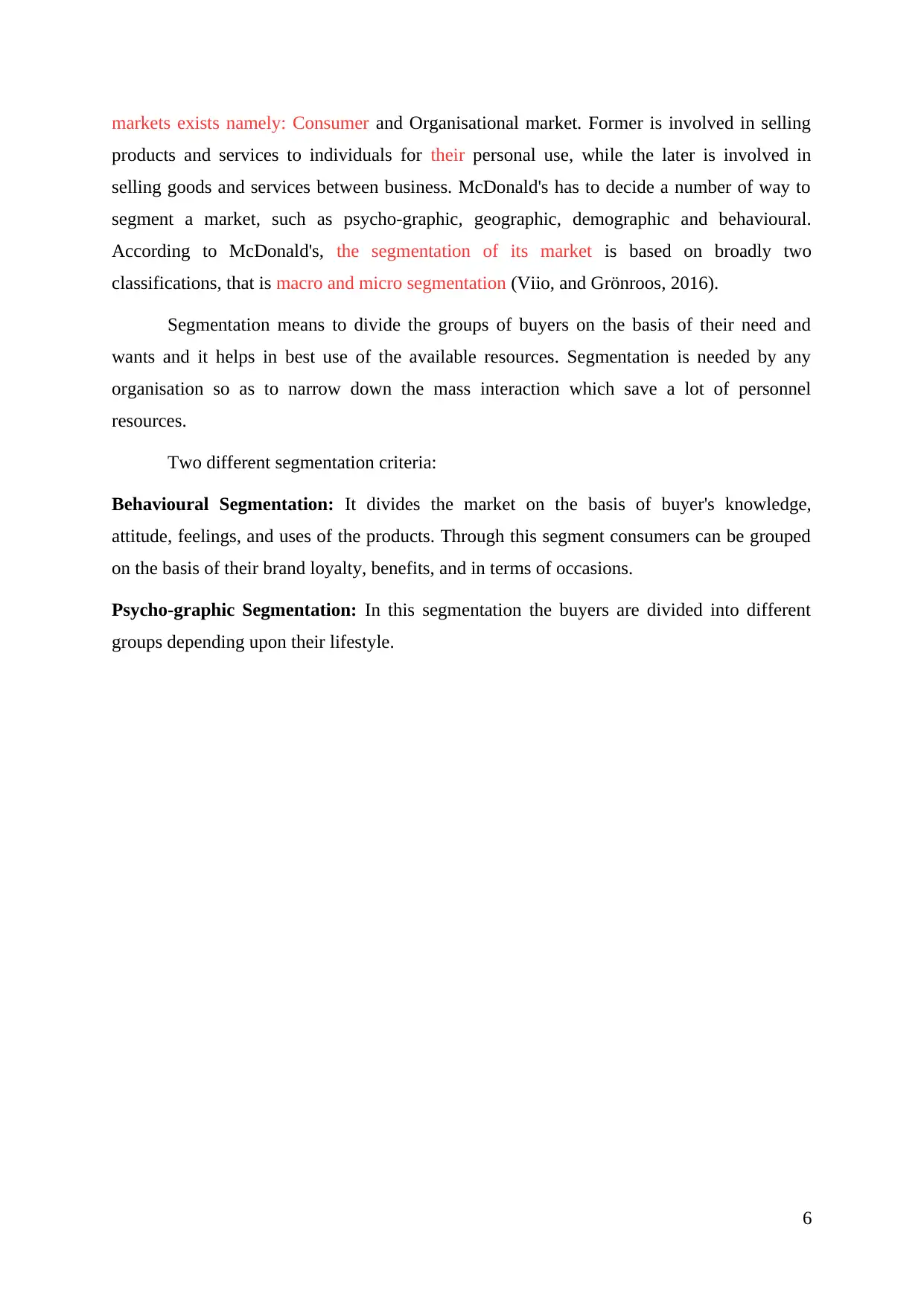
markets exists namely: Consumer and Organisational market. Former is involved in selling
products and services to individuals for their personal use, while the later is involved in
selling goods and services between business. McDonald's has to decide a number of way to
segment a market, such as psycho-graphic, geographic, demographic and behavioural.
According to McDonald's, the segmentation of its market is based on broadly two
classifications, that is macro and micro segmentation (Viio, and Grönroos, 2016).
Segmentation means to divide the groups of buyers on the basis of their need and
wants and it helps in best use of the available resources. Segmentation is needed by any
organisation so as to narrow down the mass interaction which save a lot of personnel
resources.
Two different segmentation criteria:
Behavioural Segmentation: It divides the market on the basis of buyer's knowledge,
attitude, feelings, and uses of the products. Through this segment consumers can be grouped
on the basis of their brand loyalty, benefits, and in terms of occasions.
Psycho-graphic Segmentation: In this segmentation the buyers are divided into different
groups depending upon their lifestyle.
6
products and services to individuals for their personal use, while the later is involved in
selling goods and services between business. McDonald's has to decide a number of way to
segment a market, such as psycho-graphic, geographic, demographic and behavioural.
According to McDonald's, the segmentation of its market is based on broadly two
classifications, that is macro and micro segmentation (Viio, and Grönroos, 2016).
Segmentation means to divide the groups of buyers on the basis of their need and
wants and it helps in best use of the available resources. Segmentation is needed by any
organisation so as to narrow down the mass interaction which save a lot of personnel
resources.
Two different segmentation criteria:
Behavioural Segmentation: It divides the market on the basis of buyer's knowledge,
attitude, feelings, and uses of the products. Through this segment consumers can be grouped
on the basis of their brand loyalty, benefits, and in terms of occasions.
Psycho-graphic Segmentation: In this segmentation the buyers are divided into different
groups depending upon their lifestyle.
6
⊘ This is a preview!⊘
Do you want full access?
Subscribe today to unlock all pages.

Trusted by 1+ million students worldwide
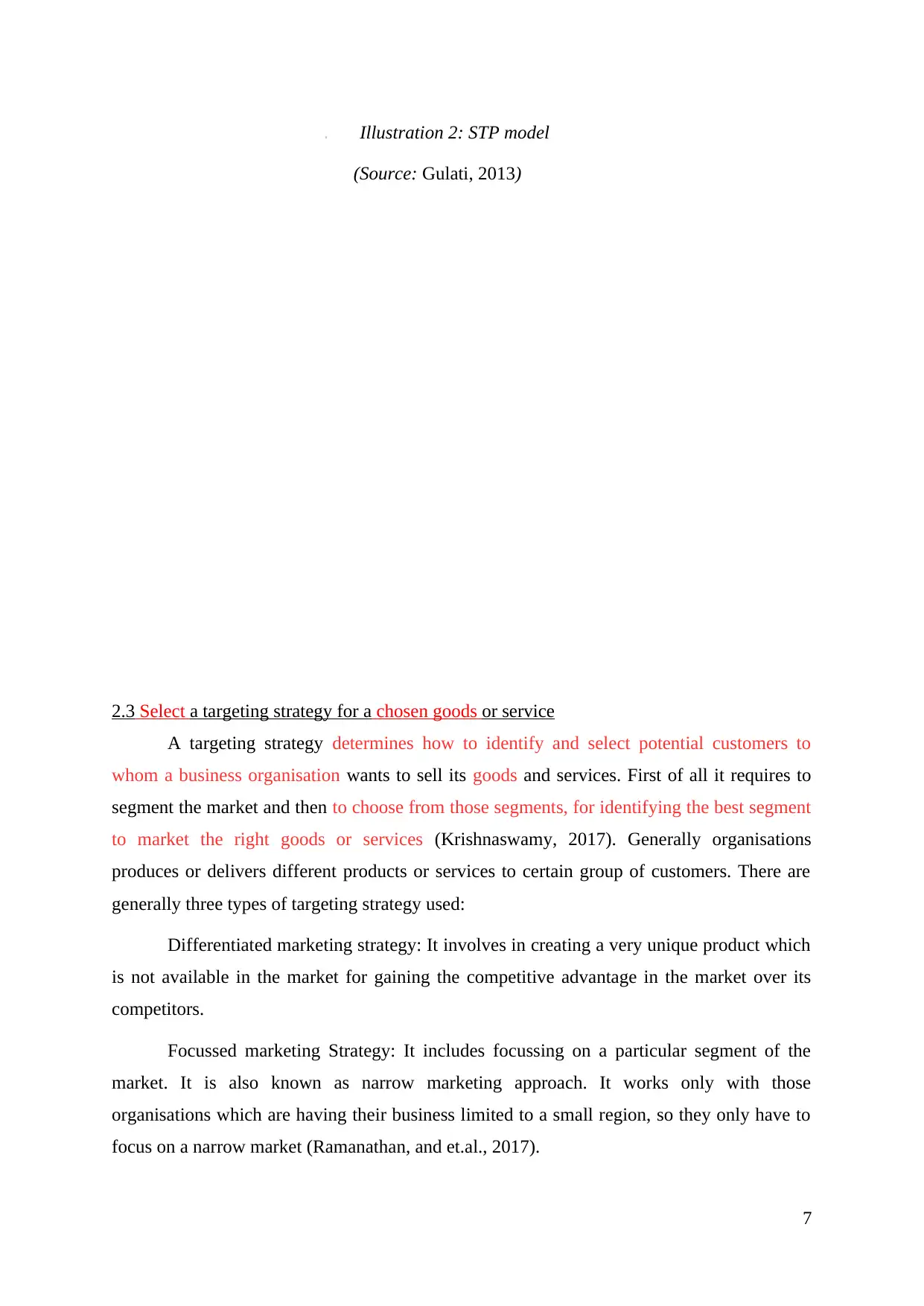
Illustration 2: STP model
(Source: Gulati, 2013)
2.3 Select a targeting strategy for a chosen goods or service
A targeting strategy determines how to identify and select potential customers to
whom a business organisation wants to sell its goods and services. First of all it requires to
segment the market and then to choose from those segments, for identifying the best segment
to market the right goods or services (Krishnaswamy, 2017). Generally organisations
produces or delivers different products or services to certain group of customers. There are
generally three types of targeting strategy used:
Differentiated marketing strategy: It involves in creating a very unique product which
is not available in the market for gaining the competitive advantage in the market over its
competitors.
Focussed marketing Strategy: It includes focussing on a particular segment of the
market. It is also known as narrow marketing approach. It works only with those
organisations which are having their business limited to a small region, so they only have to
focus on a narrow market (Ramanathan, and et.al., 2017).
7
(Source: Gulati, 2013)
2.3 Select a targeting strategy for a chosen goods or service
A targeting strategy determines how to identify and select potential customers to
whom a business organisation wants to sell its goods and services. First of all it requires to
segment the market and then to choose from those segments, for identifying the best segment
to market the right goods or services (Krishnaswamy, 2017). Generally organisations
produces or delivers different products or services to certain group of customers. There are
generally three types of targeting strategy used:
Differentiated marketing strategy: It involves in creating a very unique product which
is not available in the market for gaining the competitive advantage in the market over its
competitors.
Focussed marketing Strategy: It includes focussing on a particular segment of the
market. It is also known as narrow marketing approach. It works only with those
organisations which are having their business limited to a small region, so they only have to
focus on a narrow market (Ramanathan, and et.al., 2017).
7
Paraphrase This Document
Need a fresh take? Get an instant paraphrase of this document with our AI Paraphraser
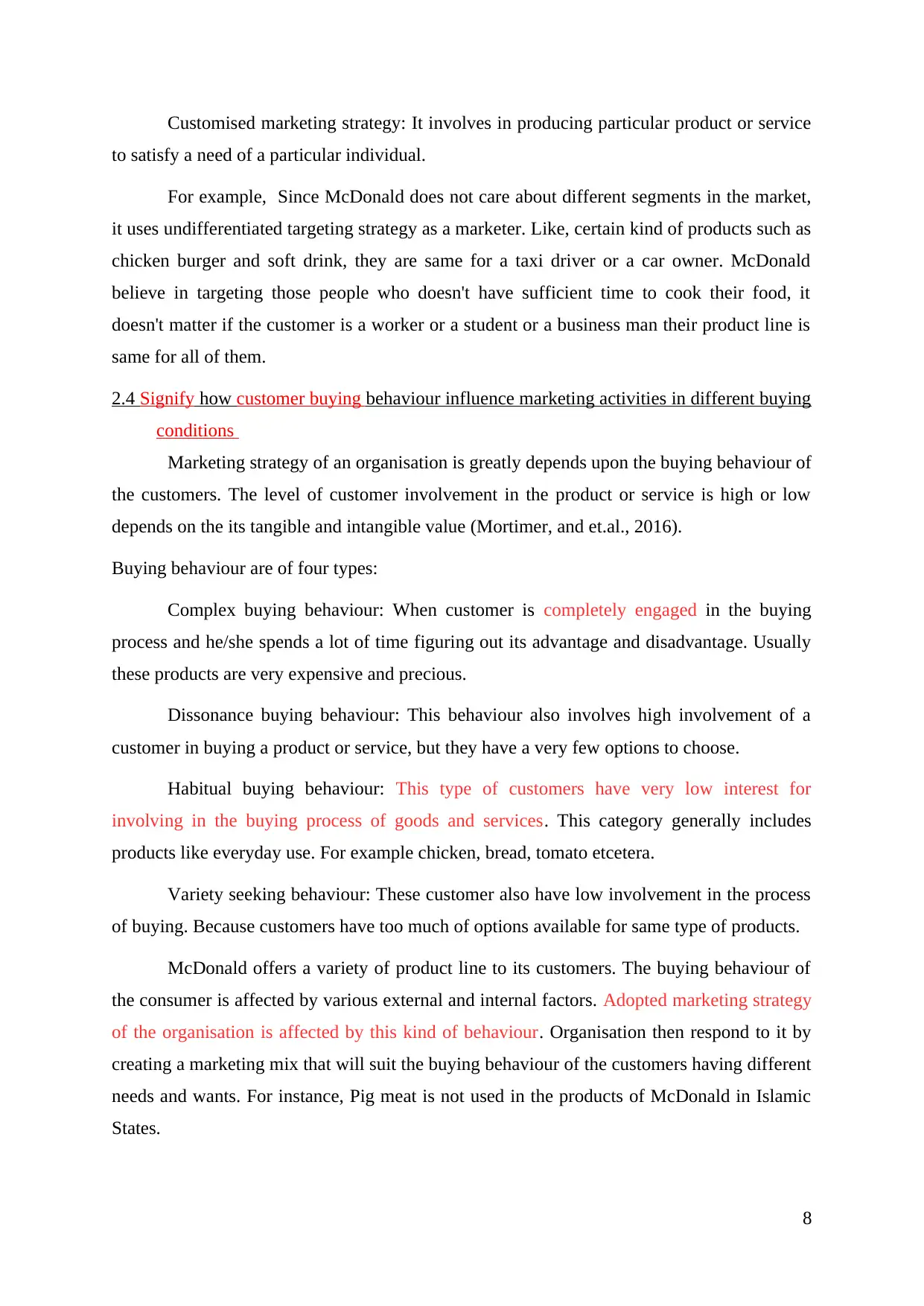
Customised marketing strategy: It involves in producing particular product or service
to satisfy a need of a particular individual.
For example, Since McDonald does not care about different segments in the market,
it uses undifferentiated targeting strategy as a marketer. Like, certain kind of products such as
chicken burger and soft drink, they are same for a taxi driver or a car owner. McDonald
believe in targeting those people who doesn't have sufficient time to cook their food, it
doesn't matter if the customer is a worker or a student or a business man their product line is
same for all of them.
2.4 Signify how customer buying behaviour influence marketing activities in different buying
conditions
Marketing strategy of an organisation is greatly depends upon the buying behaviour of
the customers. The level of customer involvement in the product or service is high or low
depends on the its tangible and intangible value (Mortimer, and et.al., 2016).
Buying behaviour are of four types:
Complex buying behaviour: When customer is completely engaged in the buying
process and he/she spends a lot of time figuring out its advantage and disadvantage. Usually
these products are very expensive and precious.
Dissonance buying behaviour: This behaviour also involves high involvement of a
customer in buying a product or service, but they have a very few options to choose.
Habitual buying behaviour: This type of customers have very low interest for
involving in the buying process of goods and services. This category generally includes
products like everyday use. For example chicken, bread, tomato etcetera.
Variety seeking behaviour: These customer also have low involvement in the process
of buying. Because customers have too much of options available for same type of products.
McDonald offers a variety of product line to its customers. The buying behaviour of
the consumer is affected by various external and internal factors. Adopted marketing strategy
of the organisation is affected by this kind of behaviour. Organisation then respond to it by
creating a marketing mix that will suit the buying behaviour of the customers having different
needs and wants. For instance, Pig meat is not used in the products of McDonald in Islamic
States.
8
to satisfy a need of a particular individual.
For example, Since McDonald does not care about different segments in the market,
it uses undifferentiated targeting strategy as a marketer. Like, certain kind of products such as
chicken burger and soft drink, they are same for a taxi driver or a car owner. McDonald
believe in targeting those people who doesn't have sufficient time to cook their food, it
doesn't matter if the customer is a worker or a student or a business man their product line is
same for all of them.
2.4 Signify how customer buying behaviour influence marketing activities in different buying
conditions
Marketing strategy of an organisation is greatly depends upon the buying behaviour of
the customers. The level of customer involvement in the product or service is high or low
depends on the its tangible and intangible value (Mortimer, and et.al., 2016).
Buying behaviour are of four types:
Complex buying behaviour: When customer is completely engaged in the buying
process and he/she spends a lot of time figuring out its advantage and disadvantage. Usually
these products are very expensive and precious.
Dissonance buying behaviour: This behaviour also involves high involvement of a
customer in buying a product or service, but they have a very few options to choose.
Habitual buying behaviour: This type of customers have very low interest for
involving in the buying process of goods and services. This category generally includes
products like everyday use. For example chicken, bread, tomato etcetera.
Variety seeking behaviour: These customer also have low involvement in the process
of buying. Because customers have too much of options available for same type of products.
McDonald offers a variety of product line to its customers. The buying behaviour of
the consumer is affected by various external and internal factors. Adopted marketing strategy
of the organisation is affected by this kind of behaviour. Organisation then respond to it by
creating a marketing mix that will suit the buying behaviour of the customers having different
needs and wants. For instance, Pig meat is not used in the products of McDonald in Islamic
States.
8

2.5 Propose a new orientating for a selected product or service
Product positioning is the strategy adopted by the organisation to distinguish itself and
its products from the rest of the competitors in the market. Effective product petitioning is
very important in the success of any organisation. This can also be done by using Product
Life Cycle method. Therefore, differentiation is the criteria through which the organisation
promotes distinct features and benefits of its goods and services (Min and Loh, 2016). By
successfully positioning a product a business can gain customer loyalty. Positioning of a
product is a marketing technique that is used to position products and services in the brightest
possible way to various segments of the market.
Positioning a product or service involves many different ways a marketer uses to
build a brand and image of its goods and services in the mind of the target customers.
McDonald should positioning its products as intended to position it in the best
available way to various target audience. Since, market segmentation and positioning of
products are related to each other and McDonald does positioning of its products in
accordance with the segmentation of the product.
TASK 3
3.1 Describe how the McDonald's products are developed in order to gaining continues
competitive advantage from the market
The business strategy of McDonald uses different arrangements of strategic
franchising and licensing, and cost leadership and international market expansion which
forms a new market entry within the companies business strategic intent.
Moreover, the strength of McDonald's is quality of the product and service or
standardization of lies cornerstone of the company. McDonald’s offer simple and uniform
menus which includes ham-burgers, cheese-burgers, Big-Macburger, Filet-O-Fish, chicken
sandwiches, Mc-Nuggets, chicken wrap, French-fries, shakes, Mc-Flurry desserts, soft serve
cones, pies, soft drinks, coffee, McCafé and many more beverages.
It is very important to maintain quality of goods and services produce to sell the
customers and McDonald's must focuses on the taste and preferences of local markets, when
creating menus (Westjohn and et.al., 2016).
McDonald's competitive advantages is based on the following points discussed
below:-
Price cheating is their main competitive advantage. The company utilises its economic of
scale to achieve the cost benefits.
9
Product positioning is the strategy adopted by the organisation to distinguish itself and
its products from the rest of the competitors in the market. Effective product petitioning is
very important in the success of any organisation. This can also be done by using Product
Life Cycle method. Therefore, differentiation is the criteria through which the organisation
promotes distinct features and benefits of its goods and services (Min and Loh, 2016). By
successfully positioning a product a business can gain customer loyalty. Positioning of a
product is a marketing technique that is used to position products and services in the brightest
possible way to various segments of the market.
Positioning a product or service involves many different ways a marketer uses to
build a brand and image of its goods and services in the mind of the target customers.
McDonald should positioning its products as intended to position it in the best
available way to various target audience. Since, market segmentation and positioning of
products are related to each other and McDonald does positioning of its products in
accordance with the segmentation of the product.
TASK 3
3.1 Describe how the McDonald's products are developed in order to gaining continues
competitive advantage from the market
The business strategy of McDonald uses different arrangements of strategic
franchising and licensing, and cost leadership and international market expansion which
forms a new market entry within the companies business strategic intent.
Moreover, the strength of McDonald's is quality of the product and service or
standardization of lies cornerstone of the company. McDonald’s offer simple and uniform
menus which includes ham-burgers, cheese-burgers, Big-Macburger, Filet-O-Fish, chicken
sandwiches, Mc-Nuggets, chicken wrap, French-fries, shakes, Mc-Flurry desserts, soft serve
cones, pies, soft drinks, coffee, McCafé and many more beverages.
It is very important to maintain quality of goods and services produce to sell the
customers and McDonald's must focuses on the taste and preferences of local markets, when
creating menus (Westjohn and et.al., 2016).
McDonald's competitive advantages is based on the following points discussed
below:-
Price cheating is their main competitive advantage. The company utilises its economic of
scale to achieve the cost benefits.
9
⊘ This is a preview!⊘
Do you want full access?
Subscribe today to unlock all pages.

Trusted by 1+ million students worldwide
1 out of 20
Related Documents
Your All-in-One AI-Powered Toolkit for Academic Success.
+13062052269
info@desklib.com
Available 24*7 on WhatsApp / Email
![[object Object]](/_next/static/media/star-bottom.7253800d.svg)
Unlock your academic potential
Copyright © 2020–2025 A2Z Services. All Rights Reserved. Developed and managed by ZUCOL.





